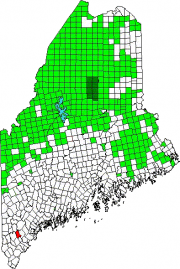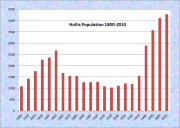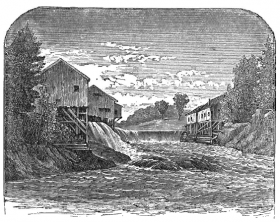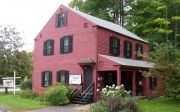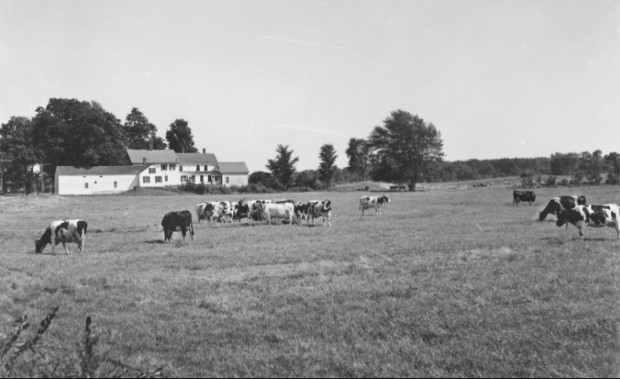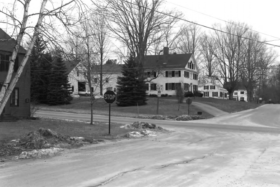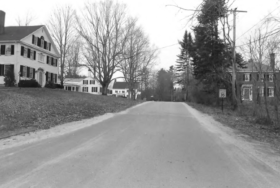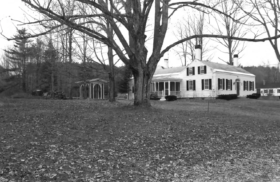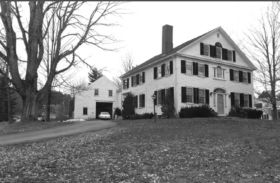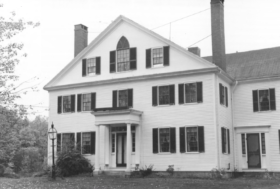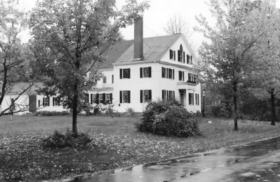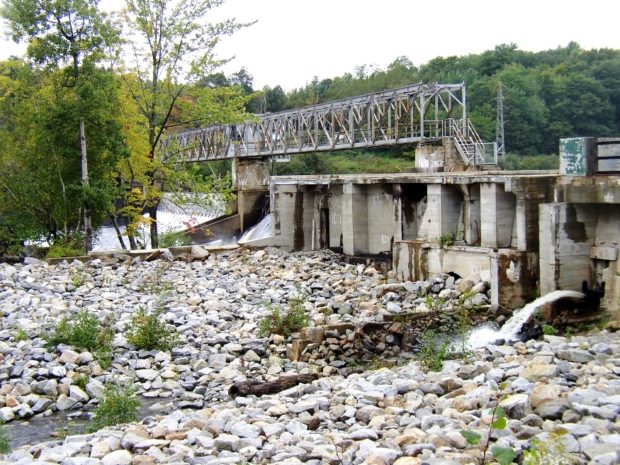
| Year | Population |
|---|---|
| 1970 | 1,560 |
| 1980 | 2,892 |
| 1990 | 3,573 |
| 2000 | 4,114 |
| 2010 | 4,281 |
| Geographic Data | |
|---|---|
| N. Latitude | 43:37:38 |
| W. Longitude | 70:37:38 |
| Maine House | District 16 |
| Maine Senate | District 31 |
| Congress | District 1 |
| Area sq. mi. | (total) 39.5 |
| Area sq. mi. | (land) 38.9 |
| Population/sq.mi. | (land)133.8 |
County: York
Total=land+water; Land=land only |
|
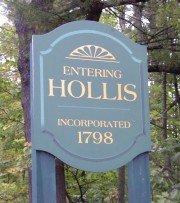 [HOLL-his] is a town in York County, incorporated on February 17, 1798 under the name Phillipsburg, later changed to Hollis on January 22, 1812. Settled in 1753, the area had been known as Little Falls Plantation at least since 1779.
[HOLL-his] is a town in York County, incorporated on February 17, 1798 under the name Phillipsburg, later changed to Hollis on January 22, 1812. Settled in 1753, the area had been known as Little Falls Plantation at least since 1779.
Commenting on the local economy in 1886, George Varney observed,
The Portland and Rochester Railroad passes through across the southern part. The station is at Hollis Centre, about 20 miles from Portland. The other centres of business are Hollis Village, on the Saco River, in the south-eastern part of the town; Bar Mills, a mile above; Moderation opposite West Buxton; North Hollis, at the north-western angle of the town; and Bonny Eagle Falls, on the Saco, at the North. At these points are lumber-mills, a spool factory and turning-mill, wood-box factory, the Saco River Woolen Company, etc.
Just 10 miles northwest of Biddeford-Saco, the town is served by U.S. Route 202 and Maine Routes 4, 35, 112, and 117. It was the summer home of Kate Douglas Wiggin, author of Rebecca of Sunnybrook Farm among other works. Her house is now the town’s library.
The Saco River, the fifth longest in the state at 121 miles, has powered many mills along its length. It provides the boundary in the east with Buxton, and in the southwest with Dayton.
The wildfires of 1947 wiped out many historic homes, so only about 20% of all housing units are more than 50 years old. These older homes are largely located on the older main roads.
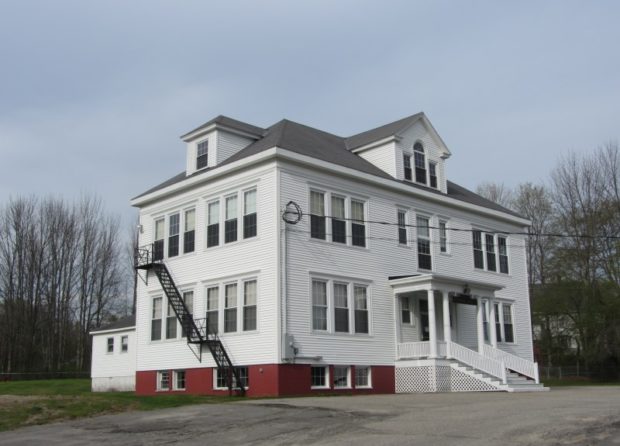
Clark’s Mills, on Route 35 near the Dayton town line is a small historic village, with little commercial development. The historic villages along the Saco River—West Buxton, Bar Mills and Salmon Falls—are partly in Hollis.
The largest of the villages with commercial development is Hollis Center, in the southern part of the Town. It contains restaurants, gasoline stations, a food market and a few other service businesses.
The largest employer in 2004 was the Poland Spring bottling plant on Plains Road. It represented the only substantial industrial use in Hollis at the time.
Congressional Medal of Honor winner:
CHARLES H. SMITH
Form of Government: Town Meeting-Select Board.
Additional resources
Bicentennial 1772-1972 Historical Souvenir Book, Buxton, Maine: August 10, 11, 12 and 13, 1972. Buxton, Me. Buxton Bicentennial Committee. 1972.
Buxton, Hollis and Limington. Dover, N.H. Arcadia. C.1997.
Hollis, Town of. Town of Hollis Comprehensive Plan Update 2005. http://www.hollismaine.org/compplan.pdf (accessed March 16, 2014)
Jewett, Martin H. A History of Hollis, Me.: Formerly Little Falls later Phillipsburg. 1976. Farmington, Me. Knowlton & McLeary Co.
*Maine. Historic Preservation Commission. Augusta, Me. Text and photos from National Register of Historic Places: http://pdfhost.focus.nps.gov/docs/nrhp/text/xxxxxxxx.PDF and http://pdfhost.focus.nps.gov/docs/nrhp/photos/xxxxxxxx.PDF
Salmon Falls (West) Historic District: 87001858.PDF
Wiggin, Kate Douglas, House: 77000142.PDF
Varney, George J. A Gazetteer of the State of Maine. 1886. p. 282-283; Bonney Egale Falls image, p. 149.
National Register of Historic Places – Listings
Salmon Falls (West) Historic District
[Salmon Falls Road and portion of US Route 202] The Salmon Falls (West) Historic District contains one of the two most architecturally significant and least altered clusters of buildings in this widely scattered village located on the Saco River. Its late 18th and early 19th century houses are important reminders of this once thriving community of small scale factories and general retail stores. The district has an intimate association with the life and literary career of Kate Douglas Wiggin (1856-1923).
Settlement in the Salmon Falls area began about 1794 when Isaac Lane occupied his property in what was then Little Falls Plantation. Three years earlier he contributed “six pounds sterling worth of labor” to the construction of a bridge at Salmon Falls. By 1795 three roads came together at or near Salmon Falls. The County Road connecting Alfred and Salmon Falls met with the River Road on the west side of the bridge. A southerly route to Dayton branched off of the County Road just to the west of the bridge intersection. Isaac Lane and his neighbor Jabez Bradbury apparently built houses in Salmon Falls in 1794. Both still stand although Bradbury’s was substantially enlarged in the 1830s or 1840s. Sometime after he settled in Salmon Falls, Lane established a general store.
About 1820 Moses Davis, a farmer, and Dr. William Sweat, a physician and surgeon, built houses to the south of Bradbury. Local historians have identified evidence of four stores and a shoe shop in or near the present district. One of these was located in the two-story frame building that now houses the village library. The abundant water resources available from the Saco River provided the motive power for both a shingle mill and a grist mill.*
Wiggin, Kate Douglas, House
[East of Hollis Center on Salmon Falls Road] “Quillcote” is important as the summer home, in later life, of the distinguished educator and author, Kate Douglas Wiggin, born Kate Douglas Smith. She and her sister Nora lost their father at an early age and, with their mother, moved to Portland. Her mother remarried and the family moved to the home of her new husband in Hollis, where Kate spent the remainder of her childhood. Her education was a mixture of tutoring by her stepfather, a year at Gorham Female Seminary, and attendance at Abbott Academy in Andover, Massachusetts.
In 1873 the family moved to Santa Barbara, California in hopes of repairing the failing health of her stepfather. His death three years later left the family in serious financial straits. In an effort to produce some income, Kate wrote and sold her first children’s story to St. Nicholas Magazine. She also enrolled in a kindergarten normal training class at a time when pre-school children’s education was just emerging as a new movement. After a short period as head of a private kindergarten in Santa Barbara, she was chosen by the Public Kindergarten Society of San Francisco to organize the first free kindergarten in California. This was located in a wretched slum, where she quickly established communication with the local residents and organized a successful school. She set up a kindergarten teacher training school at which her sister was one of the first pupils. In 1881 she married Samuel Bradley Wiggin, a Boston lawyer and friend of long standing. Three years later they moved to New York City where Kate wrote, in 1889, The Birds’ Christmas Carol, an enormous success. Samuel Wiggin died later the same year.
Despondent and in ill-health, she returned to Hollis for the summer. From then until her death she found rest and comfort in this quiet town. With the publication of Timothy’s Quest in 1890, her literary career was established. The remainder of her life was devoted to writing and an exhausting schedule of lectures and readings in the United States and Europe. On one of her trips abroad she met George C. Riggs, a New York manufacturer whom she married in 1895. He took great interest and pride in her career during the remainder of their life together. Her literary output increased and was crowned in 1903 by her greatest children’s book, Rebecca of Sunnybrook Farm which she later rewrote as a play.
In 1905 she bought the old farm house that she had admired since childhood and named it “Quillcote”, “house of the pen”. Although still spending much time travelling, “Quillcote” was from this time forward the scene of most of her literary production which included, in 1911, Mother Cary’s Chickens, also a highly successful play. She found time to contribute to the local community not the least of which was the annual tradition of presenting her short play,” The Old Peabody Pew”, in the Tory Hill Meeting House in neighboring Buxton.
She died in England in 1923, serving as a delegate to the Dickens Fellowship. Her ashes were scattered on the Saco River near “Quillcote”.


